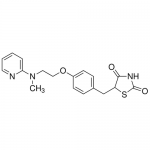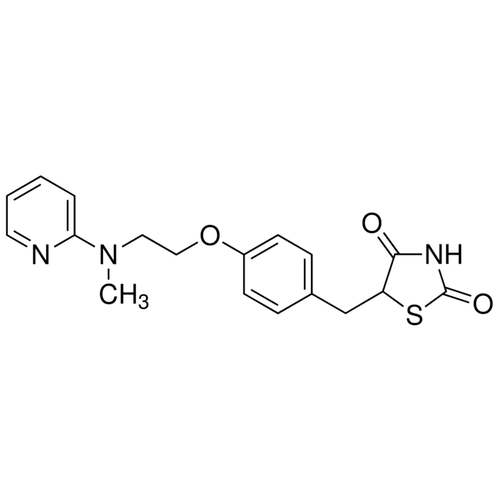| Product Name | Rosiglitazone Maleate |
| Description |
Insulin sensitizer |
| Purity | >98% |
| CAS No. | 155141-29-0 |
| Molecular Formula | C18H19N3O3S•C4H4O4 |
| Molecular Weight | 473.5 |
| Field of Use | Not for use in humans. Not for use in diagnostics or therapeutics. For in vitro research use only. |
Properties
| Storage Temperature | -20ºC |
| Shipping Temperature | Shipped Ambient |
| Product Type | Agonist |
| Solubility | Soluble in DMSO (3 mg/ml) or DMF (10 mg/ml) |
| Source | Synthetic |
| Appearance | White to off-white solid |
| SMILES | C2=C(CC1SC(=O)NC1=O)C=CC(=C2)OCCN(C3=CC=CC=N3)C.O=C(O)C=C/C(=O)O |
| InChI | InChI=1S/C18H19N3O3S/c1-21(16-4-2-3-9-19-16)10-11-24-14-7-5-13(6-8-14)12-15-17(22)20-18(23)25-15/h2-9,15H,10-12H2,1H3,(H,20,22,23) |
| InChIKey | YASAKCUCGLMORW-UHFFFAOYSA-N |
| Safety Phrases |
Classification: Caution: Substance not yet fully tested. Safety Phrases: S22 - Do not breathe dust. S24/25 - Avoid contact with skin and eyes S36/37/39 - Wear suitable protective clothing, gloves and eye/face protection |
| Cite This Product | Rosiglitazone Maleate (StressMarq Biosciences Inc., Victoria BC CANADA, Catalog # SIH-379) |
Biological Description
| Alternative Names | 5-[[4-[2-(Methyl-2-pyridinylamino)ethoxy]phenyl]methyl]-2,4-thiazolidinedione |
| Research Areas | Cell Signaling |
| PubChem ID | 77999 |
| Scientific Background | Rosiglitazone Maleate is a high-affinity agonist of peroxisome proliferator-activated receptor gamma (PPARγ), with an EC50 of 43 nM. While primarily developed as an insulin sensitizer for type 2 diabetes, Rosiglitazone has gained attention in neurodegenerative disease research, particularly Alzheimer’s disease. Activation of PPARγ has been shown to modulate neuroinflammation, enhance mitochondrial function, and improve insulin signaling in the brain—factors implicated in cognitive decline. Rosiglitazone has demonstrated the ability to rescue memory deficits in preclinical Alzheimer’s models, positioning it as a candidate for therapeutic repurposing. Its dual role in metabolic regulation and neuroprotection makes it a valuable compound in the study of neurodegeneration and brain insulin resistance. |
| References |
1. Werner A.L., & Travaglini M.T. (2001) Pharmacotherapy. 21(9): 1082-99. 2. McMorran M., and Vu D. (2001) CMAJ. 165(1): 82-3, 86-7. 3. Malinowski J.M. & Bolesta S. (2000) Clin. Ther. 22(10): 1151-68. 4. Cheng-Lai A., & Levine A. (2000) Heart Dis. 2(4): 326-33. 5. Knock G.A., et al. (1999) Eur. J. Pharmacol. 368(1): 103-9. 6. Balfour J.A., & Plosker G.L. (1999) Drugs. 57(6): 921-30. 7. Parks D.J., et al. (1998) Bioorg. Med. Chem. Lett. 8(24): 3657-8. |



Reviews
There are no reviews yet.